* (restored)
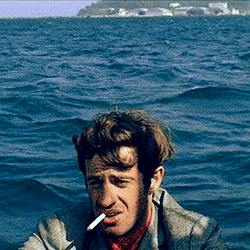
‘Jean-Paul Belmondo was born in Neuilly-sur-Seine, the son of the sculptor Paul Belmondo. He performed poorly at school but developed a passion for boxing and football. By the time he reached his twenties, Belmondo had decided to pursue a career in acting. After a number of attempts, he was enrolled at the Paris Conservatory to study drama, although his tutors were not optimistic about his prospects.
‘After graduating, he began his professional career on stage and spent the first half of the 1950s working in the theatre. He made his film debut in 1956 and appeared in several minor films over the next years, most notably Les Copains du Dimanche (1957) and his first starring role, alongside another up-and-coming new actor named Alain Delon, in Sois Belle et Tais-Toi (1957)
‘The coming of the French New Wave in 1959 finally brought Belmondo real stardom. In that year he appeared first in Claude Chabrol’s A Double Tour, which received little notice. It was his next performance, however, as the anti-hero Michel Poiccard in Jean-Luc Godard’s A Bout de Souffle, whichmade him an international star. Defiant, reckless, witty and amoral, Belmondo’s Poiccard was the perfect protagonist for Godard’s revolutionary break with the past. The success of the film even resulted in a wave of “Belmondism” in the hipper circles of Paris, with young men modelling themselves on him.
‘Belmondo revealed unexpected versatility in his next roles, acting opposite Sophia Loren in Vittorio De Sica’s Two Women (1960) and as the enigmatic priest in Jean-Pierre Melville’s World War II drama Leon Morin, Petre (1961). He worked with Godard again for the musical comedy A Woman is a Woman (1961), and with Melville on the film noir/gangster homage Le Doulos (1963).
‘In Pierrot le Fou (1965), his next collaboration with Godard, Belmondo plays a writer who leaves behind his unhappy life and sets off on a crazy road trip with the babysitter played by Anna Karina. Together they battle gunrunners, gas station attendants, and American tourists in a story that mixes high and pop culture with brilliant artistry. Standing in for Godard, as a man who cannot choose between art and life, Belmondo inhabits his character effortlessly.
‘Although he had become synonymous at this stage of his career with the films of the New Wave directors, Belmondo also played more mainstream roles in films such as the period swashbuckler Cartouche (1962), the romantic comedy La Chasse a L’Homme (1964) and Philippe De Broca’s action comedy L’Homme de Rio (1964). Capitalising on his increasing drawing power, he founded his own production company called Cerito to produce many of his films.
‘Drawing on his earlier athletic prowess, Belmondo became renowned for doing his own stunts as well as for his charming screen presence in such movies as the hit Les Tribulations d’un Chinois en Chine (1965), the comic caper The Brain (1968), and the second film with Delon, Borsalino (1970). At the same time, Belmondo appeared in all-star international productions such as Rene Clement’s all-star World War II epic Is Paris Burning? (1966), and the James Bond spoof Casino Royale (1967).
‘He continued his association with the Nouvelle Vague directors, starring in Francois Truffaut’s romantic drama Mississippi Mermaid (1969) opposite Catherine Deneuve, Louis Malle’s crime comedy Le Voleur (1967), Claude Chabrol’s black comedy Docteur Popaul (1972), and Alain Resnais ambitious biopic of a famous speculator and con man from the 1930s, Stavisky (1974).
The failure of this last film however, appears to have dissuaded Belmondo from working with the more experimental New Wave filmmakers, and, from this time forward, he began appearing almost exclusively in more commercially oriented features. Among them L’Incorrigible (1975), directed by de Broca, and the crime thrillers Peur Sur la Ville (1975) and L’Alpagueur (1976).
‘In 1978 Belmondo began a profitable collaboration with director Georges Lautner on the hit comedy thriller Flic ou Voyou. They continued their successful run with Le Guignolo (1979), Le Professionnel (1981), the comedy Joyeuses Paques! (1984), and the mystery L’Inconnu dans la Maison (1992).
‘In 1987, Belmondo returned to the stage for the first time since 1959 and divided his efforts between theatre and film from then on. Though he continued his genre work in the 1990s with the romantic comedy Desire (1996) and his third co-starring turn with Delon in Patrice Leconte’s action comedy 1 Chance Sur 2 (1998), Belmondo also branched out creatively as part of the ensemble in Agnes Varda’s homage to international cinema Les Cents et une Nuits de Simon Cinema (1995) and as the Jean Valjean figure in Claude Lelouch’s 20th century reworking of Les Miserables (1995).
‘Well regarded in the French film world as well as by movie audiences throughout his career, Belmondo was elected president of the French actor’s union in 1963, and was awarded a Cesar for his performance in Lelouch’s romance Itineraire d’un Enfant Gate (1988). He has also been made a Chevalier of the Ordre National du Merite and a Chevalier of the Legion d’Honneur. In 2001, he suffered a stroke and was absent from stage and screen until his acclaimed comeback performance in Un Homme et Son Chien (2008).’ — New Wave Film
___
Stills

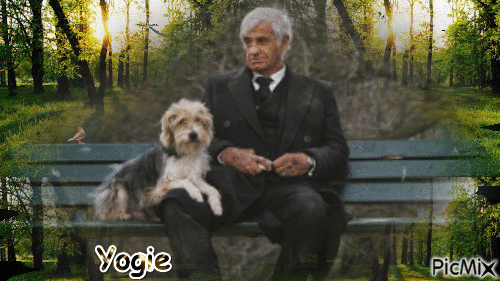
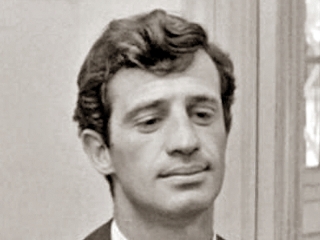
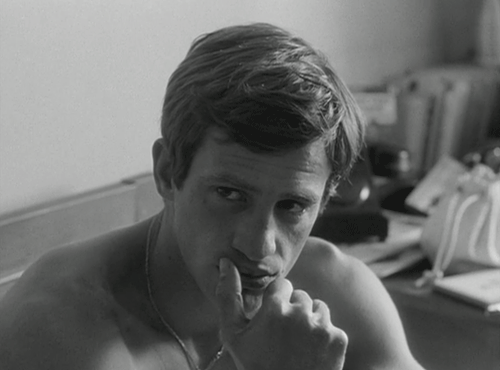




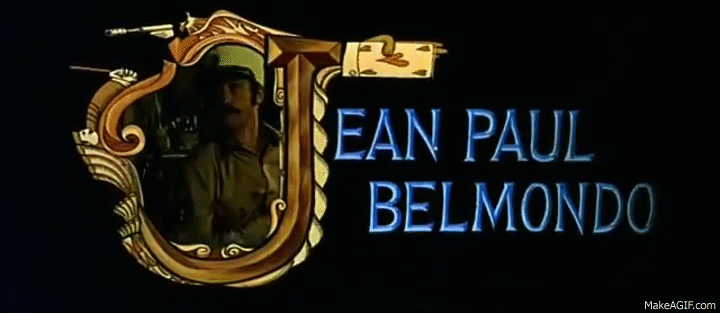



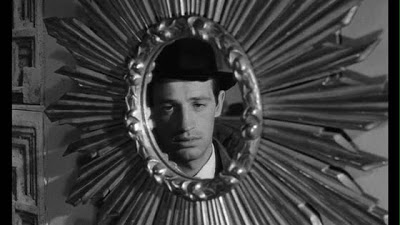





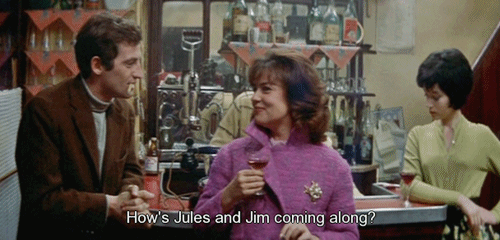
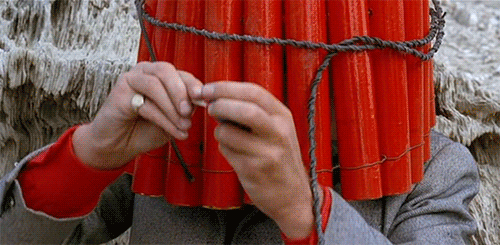
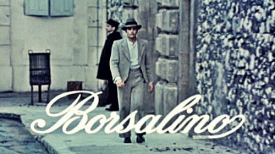













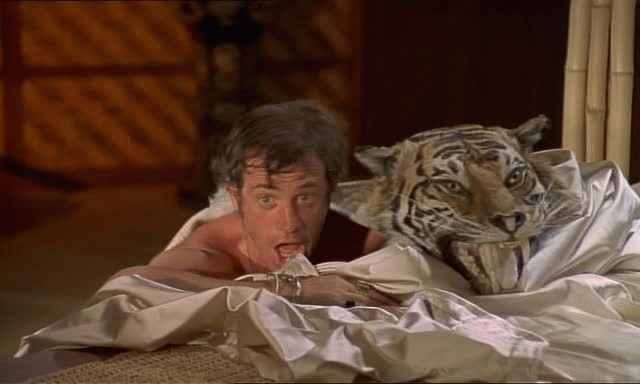



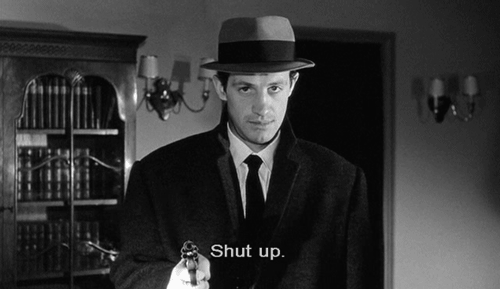

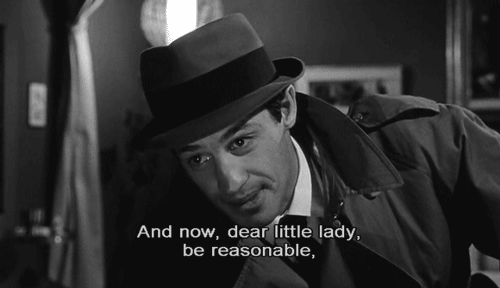

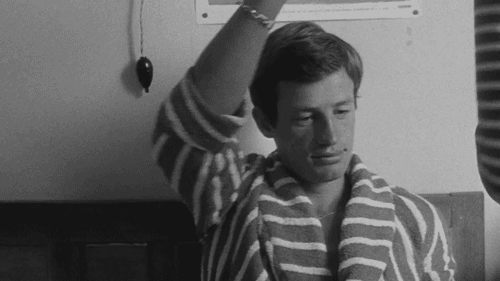
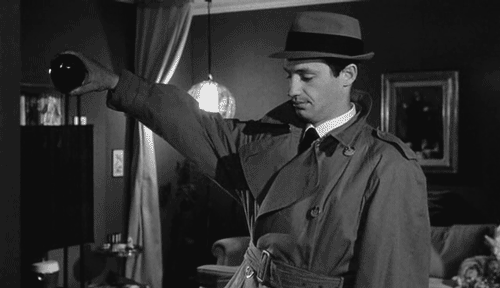


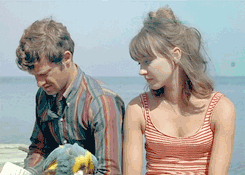

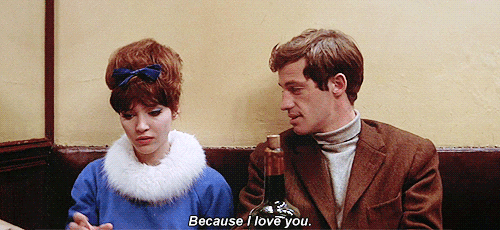

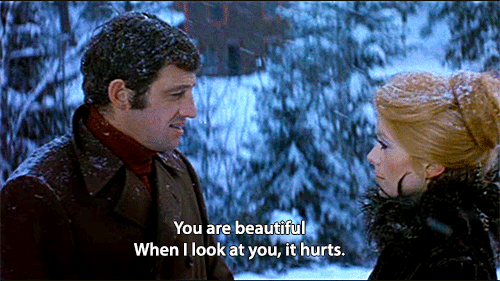
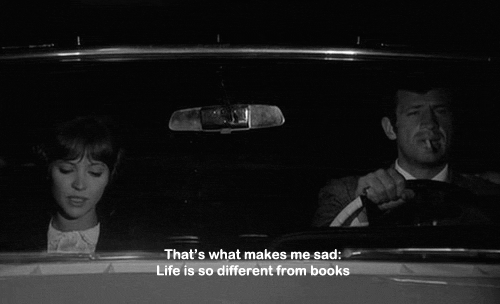

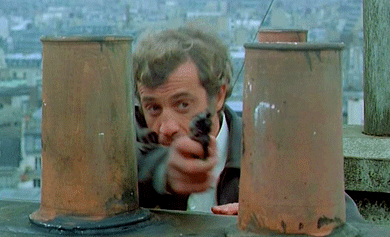

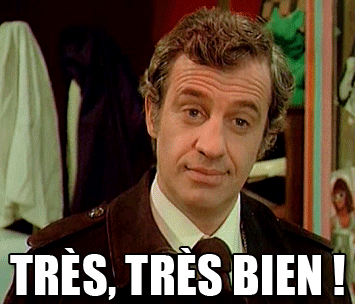
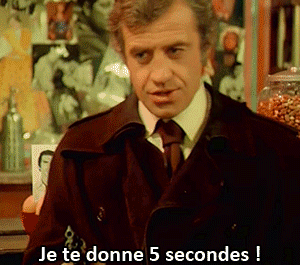

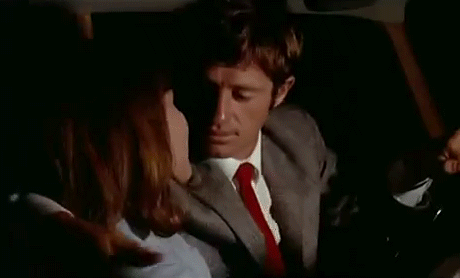
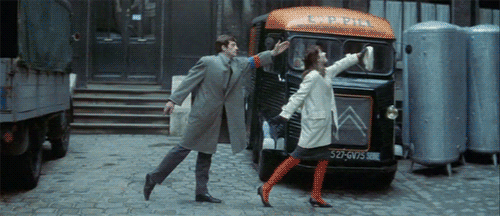
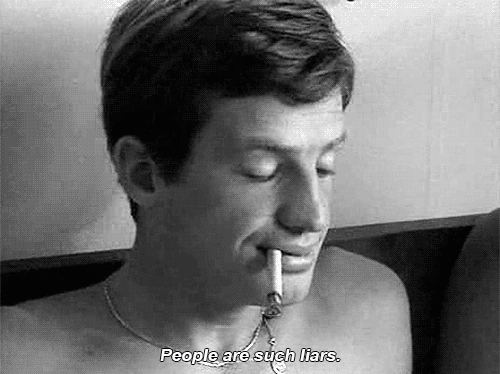
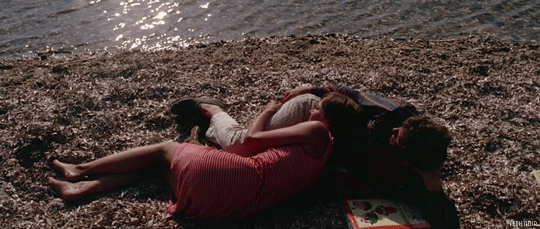

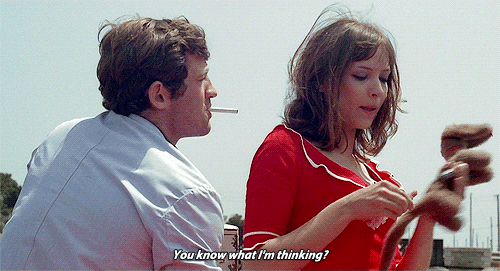
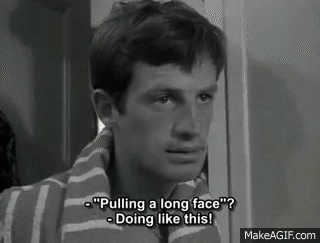
___
Further
Jean-Paul Belmondo @ IMDb
Jean-Paul Belmondo Fansite
Video: ‘C’est quoi Jean-Paul Belmondo ?’
‘Jean-Paul Belmondo in saga of love, death threats and lap-dancing clubs’
‘Jean-Paul Belmondo : «C’est la dernière fois que je parle»’
J-PB @ Films de France
J-PB page @ Facebook
‘Jean-Paul Belmondo : “Avec Alain Delon, on se disputait souvent”‘
Poem: ‘Jean-Paul Belmondo’,
BY VALZHYNA MORT
‘Lelouch : “Jean-Paul Belmondo a inventé Godard”‘
J-PB @ The Criterion Collection
‘Rafae Nadal is in final stop of career: Jean-Paul Belmondo’
Video: ‘comment Jean-Paul Belmondo est devenu une icône’
‘Jean-Paul Belmondo, 82 printemps en 25 photos culte’
‘Jean-Paul Belmondo : “Le dernier des classiques”‘
____
Extras
Jean-Paul Belmondo – Interview (1959)
Jean-Paul Belmondo 1961 interview
Epreuve de casting (1964)
Jean Paul Belmondo chez Monsieur Cinéma en 1975
Vivement Dimanche: Jean-Paul Belmondo (2008)
____
Interview
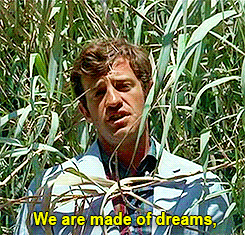
Which of your films do you hold the first?
JEAN-PAUL BELMONDO. ” Breathless “. This is the first film that brought me glory. I did not imagine it would be a success. And Jean Seberg was like me. We shot without lights, without anything. But the text was good. In the end, Seberg told me, “He will not release this movie. ”
Did not you mind dying in the end?
No, I agreed on everything. Godard told me, “He’s a guy who meets a girl, and at the end, maybe he’ll be dead or not. Godard has always been kind to me. And I did what he asked. I even sang in “Pierrot le Fou”.
Did you have a lot of fun on filming?
Yes, our big game, completely stupid, was to destroy the hotel rooms. We threw all the furniture out of the windows, I hope we did not hurt anyone …
Did you have rock star behavior?
Yes … It happened to me today, thankfully.
With Gabin, on the set of “A Monkey in Winter”, how was the atmosphere?
At first, a little cool. We went for a coffee and when I paid the bill, I wanted to pay. He said to me, “No, everyone’s his share! I thought: it’s gone wrong. After, it was a love. In scenes of drunkenness, we were never drunk. But in the evening, we had java together, we drank shots of whiskey. He told me about his life, his career, and I was very interested. And then we talked about football, boxing, cycling. He arrived the next morning, saying: “My head hurts, so a ham and a salad. It was really happy.
It is striking to see these cascades of extreme danger that you realize yourself! You were a real daredevil …
When I was six years old, I was already hanging on the stairs of the fifth floor and I was walking on the rooftops. I liked it a lot, but my mother was scared. The stunt Gilles Delamare advised me to do the first stunts in the “Man of Rio”. I must say that, hanging on this cable between two buildings of Brasilia, I was a little afraid. He guided me not to fall.
You had the baraka not to hurt you more …
I never thought of death. Once, on a car crash, I had a broken leg – six months in the cast – and a vertebral corset. But I had muscles for that, and I was doing a lot of muscle training to talk to. I remember a flight to New York in Concorde. Suddenly, over the Atlantic, one engine breaks down, then a second. The hostesses are drinking for everyone because people are starting to panic. A guy gets up and throws at me, “Do something, Mr. Belmondo. What could I do? (Laughter). Me, I did not think we would fall, but the passengers, yes. Finally, the plane landed without damage.
As a former boxer, did you like casting in life too?
Yes, but it was years ago. The punches were good. We were banging on each other, and then we drank one shot together. Now, it’s no longer that at all, the guys come out a knife or a gun right away.
You have always been a great seducer ...
It is true that I held in my arms beautiful women … Lollobrigida, Sophia Loren, Claudia Cardinale. With Ursula Andress, we stayed together for several years. But they made me a pretty exaggerated reputation as a great seducer.
Women had to wait for you every night at your hotel …
Oh yes, that. It was good (laughs). It was a time of carelessness. We were leaving at the end of the world to turn. Hong Kong, Nepal, India. In Kathmandu, for “the Tribulation of a Chinese in China,” people had almost venerated me when I saw myself grabbing a rope in the air. They had never seen that.
“Borsalino” does not appear in your box. Why ?
For rights issues. I wish he were there. For Alain Delon. I have always loved him. At the time, we were both actors who walked, so we had to fight. We quarreled a little, but three times nothing. He has always been there in difficult times.
You can look back on your life …
No, not so much, you have to live with your time. I am always surprised and very happy that people stop me for autographs. I love them so much, people.
Will you see you again at the cinema?
You’d have to find a funny character, who misses the use of an arm and who has difficulty with one leg. Maybe the role of a guy who comes back from the war. Me, I’m like all actors, I never finished. If I am offered a role that I like, I will do it.
_________________
17 of Jean-Paul Belmondo’s 90 films
_____________
Claude Chabrol À double tour (1959)
‘A double tour, Claude Chabrol’s third film, is his debut psychological thriller, a genre he subsequently transformed in films like Les Bonnes Femmes and L’Enfer. Through (expert use of flashbacks and vignettes – NY Times) Chabrol creates a lurid and disturbing melodrama of infidelity, obsession and murder at a vineyard in rural Provence. Vintner Henri Marcoux (Jacques Dacqmine) brazenly carries on an affair with a beautiful young neighbor (Antonella Lualdi) right under the nose of his bitter wife Thérèse (Madeleine Robinson). Henri’s gorgeous daughter has herself caught the eye of a Hungarian ne’er do well (Jean-Paul Belmondo), while Henri’s voyeur son begins to take liberties with his father’s mistress. As the family’s passions ripen, the stage is set for tragedy. Demonstrating (a flair for the camera and characterization – NY Times) Chabrol leads his gifted cast through (fine performances – NY Times). Italo-Greek ingénue Antonella Lualdi is a (dark, striking beauty who could easily turn a man’s head – NY Times), and storied French stage actress Madeleine Robinson (Orson Welles’ The Trial) received the Best Actress prize at the 1959 Venice Film Festival for her role. Belmondo is magnetic in his final part before Breathless (in which he used his character’s name from A double tour as an alias) catapulted him to international stardom. Released in the US as Leda in 1961, Variety called A double tour a (sleek whodunit,) with (good camera work and tricky direction.) Viewed today, A double tour’s swooping camera and character eccentricity echo both Alfred Hitchcock’s most personal and obsessive films and Douglas Sirk’s colorful 1950s melodramas.’ — collaged
Excerpt
_______________
Jean-Luc Godard Breathless (1960)
‘The opening of Breathless is “unprecedented,” in that we never learn what route brought Michel Poiccard to the Vieux Port of Marseille, where he surveys the future from the very edge of France. This first shot strikes a match to touch off an oil fire that will race through the film’s incidents and images, indeed through the New Wave altogether. A girlie tabloid filling the screen slips down to reveal the face of Jean-Paul Belmondo, cigarette dangling from his lips, as he looks out from under his rakishly cocked hat. His head swivels, and he rubs those lips with his thumb; he is ready for action. At a signal from a female accomplice, he hot-wires a big Oldsmobile just parked by an American military man touring with his wife. Abandoning the girl, who begs to be taken along, Poiccard drives off, exhaling in the flush of freedom, “Maintenant je fonce, Alphonse!” We can feel Godard’s own outlaw freedom in this sequence, carjacking a Hollywood genre and putting it into drive. The film lurches forward as he shifts up with wild shot changes; it charges ahead (il fonce) on bursts of music and sound effects, and on Belmondo’s spontaneous speeches, directed right to the camera, to us. Character and auteur will gun down the French authorities when stopped for questioning. From Marseille, Poiccard makes his way to Paris, to the Cathedral of Notre Dame and the Latin Quarter, then to the Champs-Élysées and its movie theaters (right under the offices of Cahiers du cinéma), where he shares the street with the crowds cheering Charles de Gaulle, head of the brand-new Fifth Republic. He will wind up in Montparnasse, on the rue Campagne-Première, the legendary street where Kiki hung out, as did Man Ray, Marcel Duchamp, Francis Picabia, and Yves Klein. Breathless brings anarchy into the heart of Paris.’ — Dudley Andrew
Excerpt
Excerpt
Excerpt
_______________
Peter Brook Moderato cantabile (1960)
‘One of those movies that mesmerizes through its restraint, this is set in a dreary coastal small town—familiar territory for French cinema—where Anne Desbarèdes (Moreau) is the beautiful, bored wife of the principal local employer (Deschamps); “No,” she says at one point, summarizing not just the starkness of the place but her own life there, “summer never comes in this region. It’s always windy.” One afternoon she’s watching her young son Pierre (Haudepin) take his piano lesson from the elderly Miss Giraud (Regis) when his faltering rendition of Anton Diabelli’s Sonatina in F (op 168 #1, first movement indicated as moderato cantabile) is interrupted by a long, uncanny howl of agony. Investigating, Anne and Pierre discover that a man (Valeric) has murdered his lover in a nearby bar, the Café de la Gironde, a place that seems normally a territory open only to men and whores. Anne catches the eye of one of the bar’s regulars, Chauvin (Belmondo), who happens also to be one of her husband’s countless employees. She asks him if he knows the backstory of the murder, and he tells her he’ll do his best to find out. Although the bar’s owner (de Boysson) tells him that no one knows anything about the matter, Chauvin invents details to impart to Anne: “Maybe he wanted to kill her very early on, from the moment he first saw her.”’ — Noirish
Excerpt
________________
Jean-Luc Godard Une femme est une femme (1961)
‘Une Femme Est Une Femme – Jean-Luc Godard’s first venture in colour – perfectly captures the spirit of French New Wave cinema. The movement, pioneered in the late 50s and early 60s, rejected popular cinematic formats, seeking out new and alternative subject matters; it frequently touched upon social issues, while embracing a youthful spirit and experimental approach to form. Godard’s 1961 masterpiece features his long-term muse, a playful Anna Karina, whom he married during the film’s production. The story focuses on the relationship between Karina’s character Angéla, a strong willed exotic dancer who is desperate for a child, and her unwilling lover Émile, who isn’t so keen on the idea. Throughout the film, Angela shines through as a woman of great conviction and courage in what is a remarkable study of female independence in 1960s France. Here we look at some of her best moments, and what we can learn from them.’ — AnOther Magazine
Trailer
Title sequence
Excerpt
________________
Jean-Pierre Melville Léon Morin, Priest (1961)
‘Jean-Paul Belmondo delivers a subtly sensual performance in the hot-under-the-collar Léon Morin, Priest (Léon Morin, prêtre), directed by Jean-Pierre Melville. The French superstar plays a devoted man of the cloth who is desired by all the women of a small village in Nazi-occupied France. He finds himself most drawn to a sexually frustrated widow—played by Emmanuelle Riva—a religious skeptic whose relationship with her confessor turns into a confrontation with both God and her own repressed desire. A triumph of mood, setting, and innuendo, Léon Morin, Priest is an irreverent pleasure from one of French cinema’s towering virtuosos.’ — The Criterion Collection
Trailer
JEAN-PAUL BELMONDO ON “LEON MORIN, PRIEST”
_______________
Jean-Pierre Melville Le doulos (1962)
‘This 1962 film, Melville’s seventh feature, was his first true foray into the post–film noir, so-called Série noire crime genre in which he would subsequently forge some of his most celebrated works: Le samouraï, Le cercle rouge, and Le deuxième souffle. Yes, Melville’s 1956 Bob le flambeur told the tale (eventually!) of a casino heist, and his 1959 Deux hommes dans Manhattan has its eponymous two men undertake a missing-persons case. But both films are discursive, rambling affairs, often concentrating on the charms of their respective settings (the fairy-tale sleaze of Bob’s Montmartre/ Pigalle, the Broadway bright lights of Deux hommes), and ending things reasonably well for their heroes (Bob le flambeur, in particular, is one of the greatest shaggy-dog stories ever put on film). In Le doulos, Melville makes his genre move with a vengeance; for all its atmospheric touches, it has a relentless forward movement unprecedented in any of his prior films. Which is at least slightly paradoxical, as all of Le doulos’ characters are living in the past.’ — Glenn Kenny
Trailer
________________
Jean-Pierre Melville L’aîné des Ferchaux (1963)
‘A venerable banker from Paris leaves for America when he discovers there will be an investigation into his questionable business deals. Accompanied by his faithful protégé Michel (Jean-Paul Belmondo), the pair travels to New York by plane and eventually to New Orleans by car. Michel plans to make off with the boss’s money, but feelings of loyalty for the old man prevent him from carrying out his planned heist.’ — Dan Pavlides, Rovi
Excerpt
Excerpt
_________________
Marcel Ophüls Peau de banane
‘Peau de banane is only watchable thanks to its top-notch cast, but they cannot make it unforgettable. There is simply no rhythm in the plot, stuff happens and there never is a consistent effort to come up with a real twist so it is all boringly linear. The worst is that with this cast you hope something will eventually happen, so you seat the whole movie through and unfortunately this only helps to prove it is entirely devoid of imagination, snappy situations or even finely chiselled characters. I would say crook comedy is basically an easy genre just like heist movies, yet you have to really try to make it interesting. It cannot be the story of a sting only with minor bumps. I can’t even think of one great scene – let alone a brilliant one. So this movie fully deserves to have fallen into oblivion.’ — vostf
Excerpt
________________
Jean-Luc Godard Pierrot le Fou (1965)
‘In his earlier films, Godard had relied on preexisting frameworks to guide his spontaneous invention, whether Hollywood genres (as in Breathless, Band of Outsiders, and Alphaville) or the intellectual modernism of Brecht or Barthes (as in Vivre sa vie and A Married Woman). But by the time he started shooting Pierrot le fou, the film noir conventions underlying it no longer inspired him, and his theoretical references were in a state of flux due to his political anger as the Vietnam War escalated. The result of Godard’s personal, cinematic, and intellectual turmoil was an immediate creation that reached, even for Godard, new heights of spontaneity and lightning invention—and this was largely an effort to compensate for his inability to be methodical even by the casual terms of his own practiced methods. Shortly after completing the film, he told Cahiers du cinéma: “In my other films, when I had a problem, I asked myself what Hitchcock would have done in my place. While making Pierrot, I had the impression that he wouldn’t have known how to answer, other than ‘Work it out for yourself.’” Godard had had trouble working it out. Classic Hollywood forms couldn’t sustain him as they had in his previous film, Alphaville, which depended heavily on the conventions of the secret-agent and science-fiction genres. Not only was his absorption of the entire classical cinema of no help to him, but also his own experience as a filmmaker was of little use. He said that, in making Pierrot le fou, he felt as if he were making his “first film”; he had lost his North Star of cinematic navigation, and was out at sea.’ — Richard Brody
Trailer
Excerpt
Excerpt
__________________
Rene Clement Is Paris Burning? (1966)
‘Hollywood has long been skillful in turning good books into bad movies, but Is Paris Burning is an unfortunate perversion of that well-worn theme–it takes a pretentious chunk of bad journalism and turns it into an even worse film. One is nearly awestruck at the achievement, which is perfectly fine since the only other reactions the film could possibly produce are boredom and fury at having paid the whopping three dollar admission. Paris is so interminably long, so badly acted, so deliciously incoherent that it could very well be the flop of the year, nay, the decade. The acting is a monument to awkwardness. Only Jean Paul Belmondo seems to see the ludicrous futility in it all–he looks as if he were going to wink at any moment.’ — The Harvard Crimson
Excerpt
_________________
Louis Malle Le voleur (1967)
‘Louis Malle based loosely his movie on the book by Georges Darien, novelist committed against parliamentarism, clericalism, militarism, colonialism, etc. The filmmaker himself noted the similarities between himself and Georges Randal: same social background, same revolt against the conservative bourgeoisie, same desire to rupture and destruction. The Thief, overall, is not only an adventure film, it is also a reflection on power and money, as well as a satire of the French “bourgeoisie”.’ — Cine Club
Excerpt
Excerpt
________________
Francois Truffaut Mississippi Mermaid (1969)
‘Mississippi Mermaid has the form of a preposterous romantic melodrama, but it is so full of lovely, complex things – of unannounced emotions, of ideas, of the memories of other movies (Truffaut’s, as well as of those of two of his father-figures, Renoir and Hitchcock) – that it defies easy definition and blithely triumphs over what initially appears to be structural schizophrenia. This bewitching, circuitous love story starring Catherine Deneuve and Jean-Paul Belmondo at their most dazzling. It is the creation of a superior moviemaker who works eccentrically in the classical tradition.’ — Vincent Canby
Excerpt
_______________
Jacques Deray Borsalino (1970)
‘Jean Paul Belmondo later sued Delon over the matter of billing – the words “an Alain Delon Production” appeared before Belmondo’s name in the credits, resulting in Belmondo taking Delon to court. Delon said when promoting the film in the US: “We are still what you in America call pals or buddies. But we are not friends. There is a difference. He was my guest in the film but still he complained. I like him as an actor but as a person, he’s a bit different. I think his reaction was a stupid reaction… almost like a female reaction. But I don’t want to talk about him anymore.” Delon’s associate producer, Pierre Caro, later claimed at the same time: “If you ask me, I think Belmondo was afraid from the first to make a picture with Alain. He demanded the same number of close ups. Alain had to cancel a lot of his best scenes because they made him look better than Belmondo. My own feeling is that they will never work together again. Alain says they will but he lies.” Director Jacques Deray reflected, “All through production Delon was impeccable, never interfered. But when the film was completed Delon the producer stepped in and took it over.”‘ — collaged
Excerpt
Excerpt
______________
Alain Resnais Stavisky… (1974)
‘Alain Resnais’ Stavisky shares only its brilliance with his other work. His films have never had a consistent visual style, if only because he begins with such dissimilar material and then tries to find a look for it that’s appropriate. But even so, we’d hardly anticipate this elegant, sparkling period piece from the director of Hiroshima Mon Amour and La Guerre Est Finie. Resnais sets his film in the France of the early 1930s, when a shaky economy is being held together by the lies and bluffs of the ruling class. One of the greatest of the manipulating financiers, and certainly the most fascinating, is Alexandre Stavisky, the emigre son of a Russian Jewish dentist, who’s parlayed his personal charm and confidence schemes into a vast stock swindle. To play Stavisky, Renais chose Jean-Paul Belmondo, and it’s perfect casting. There’s something in Belmondo’s screen personality that fundamentally suggests the con man. It was there in the jauntiness of his first movie, Breathless, and in Cartouche, a movie totally unlike this one except for Belmondo’s cocky bravado in the face of certain defeat Belmondo has grown and become more subtle in 15 years, and in Stavisky, he gives us his most complex and probably his best performance.’ — Roger Ebert
Trailer
Interview de Jean-Paul Belmondo 1974 sur le film Stavisky
__________________
Claude Lelouche Itinerary of a Spoiled Child (1988)
‘Along with a strong visual sense that makes the most of his locations, Lelouch uses a fluid timeline, drifting back and forth for much of the first quarter, but unlike his more self-indulgent ensemble pieces here there’s always a clear sense of where the film is going and why we should care about these people. On one level it’s a curious mix of drama, light comedy, mild romance and feelgood whimsy that has a bit of everything without ever going all out in any one direction, yet somehow it all works rather perfectly. The hesitant Anconina’s an amiable foil but it’s Belmondo’s performance that really anchors the film with a perfect mixture of star quality and underplayed heartfelt acting as a man who has everything but, though he’ll never admit it, knows he’s somehow not got anything really right along the way and, having broken all his toys, tries to walk away. It’s not a particularly profound or insightful script, though it is much better than usual for Lelouch, but the star and the filmmaking manage to elevate the material to something surprisingly satisfying.’ — Trevor Willsmer
Trailer
Excerpts
__________________
Agnes Varda One Hundred and One Nights (1995)
‘One Hundred and One Nights was made in the not insignificant year of 1995, to mark the centenary of cinema, and the film celebrates the art form in its own peculiar narrative – our central character is Monsieur Cinema (Michel Piccoli), a centenarian in a mansion losing his memory, who wants to relive cinema while also being a very obviously allegoric personification of cinema itself, assuming the look of characters as varied as Nosferatu and Norma Desmond. He hires a young cinephile (Julie Gayet) to come each evening (“between the hours of 5 and 7”, a cheeky reference to Varda’s own landmark film, Cleo from 5 to 7) to come and remind him of films past – describing the legendary opening shot of Orson Welles’ Touch of Evil, for example. In between he is visited by a parade of legendary film stars who stop and talk, some as themselves, some as characters, in what becomes a showcase revolving door for a who’s who of post-war European cinema. In addition to Piccoli and Mastroianni with the meatiest parts, we are joined by Catherine Deneuve, Jean-Paul Belmondo, Gerard Depardieu, Jeanne Moreau in addition to Robert De Niro and blink-and-you’ll-miss cameos from Clint Eastwood and Harrison Ford, amongst many others. Some are instantly recognisable, others less so (Belmondo did not age as gracefully as come of his colleagues) as they swap stories, relive moments. It’s flimsy and paper-thin as a gimmick, but too enjoyable and luminescent in its star power, while never taking the film too seriously, with the actors addressing the camera continuously and going in and out of character – Piccoli, not only is Monsieur Cinema, but himself; he takes his wig off with Marcello as they compare their respective bath scenes in both Contempt and 8½.’ — 4:3
Trailer
_______________
Bertrand Blier Les acteurs (2000)
‘Les Acteurs is the absurd story of Jean-Pierre Marielle desperately waiting for a cup of hot water, the story of a conspiracy against actors, the story of aging actors whose careers are slowly less active than they used to be, but a stunning tribute to French actors and their cinema. Supported by a solid reflection about cinema and acting (the fourth wall, the hidden cameras, to play or not to play), the story of this film in which most of those famous actors play their own role (not to be mixed up with living their life in front of the camera – the film is not voyeur) is quite vague, and follows the actors in series of episodes which make the film quite amusing. As André Dussolier quits the film and leaves Josiane Balasko to play his part (great actress, she’s hilariously serious especially when, in Dussolier’s role, she bitches about herself), as actors run in each other on the street, asking for autographs, as fights and gossip happen, we recognize pastiche of other scenes in which each (or others) have played. Actually, for whoever does not know the actors (most of them being at least in their 50s) or does not know French Cinema, this movie has less interest, since most of the references will be missed, but it will still offer a good track of reflection on aging, on acting, on public life…’ — Oreste
Trailer
[Making of] ‘Les Acteurs’
*
p.s. Hey. ** David Ehrenstein, Hi. Happy to hear the Kurosawa event went so well. Kicking myself that I wasn’t there to go. Any chance it was videoed? ** Kytuna, Grandma’s basement, exciting! I saw the Offspring live once ages ago. It was surprisingly fun. Huh, interesting proposed career trajectory. My first published fiction book(let) was so, so, so bad that I almost pray all the extant copies wound up in Paradise, California. I haven’t been to the Grevin in ages, and it’s walking distance, and it’s right next to Hard Rock Cafe. I think a cheeseball field trip is in the offing. ** Nik, Hi! Super glad that you found the post interesting. Yeah, very curious medium. A collaborative director is key, I think. Gisele is very collaborative with her performers, such that they feel like it’s their work too, which it is, and I think that makes a huge difference. Yeah, that sounds to have been a very, very interesting piece/experience. I do like the ARTE script. I do think the TV series will be really good. And I think trying to finesse what amounts to compromising is quite a useful exercise, but it’s just not anywhere near as pleasurable to write as something wherein either I am the boss, or Zac and I are, or a super-trusted, same-brain-wave occupying someone like Gisele is. Well, trying to preserve the experiments in the earlier versions of the script while housing them palatably is certainly an experiment, I guess. Thanks, man. It’ll be good. I’m just spoiled basically, ha ha. Have a great one. ** _Black_Acrylic, Hi. I don’t think those qualify since I believe a tableau vivant involves either in-person real-time observing of a static set-up or seeing its documentation in real-time video form, but maybe the actual photo shoots had a tableau vivant-like thing for the photographers? If you’re feeling increasingly confident, the class is a great success. When you present the finished story will there be as situation where a more thorough feedback will be possible? Great, man. ** Joey, Hi. I’m good, working and stuff. Great about the raise, congrats! Hi to Jarrod! The email you sent was empty. There was nothing in it. I’m not sure why. Can you resend? Love, me. ** Misanthrope, Hi, G. Oh, yeah, ‘Remains of the Day’ is very good. I often forget about Ishiguro, but he’s quite a good scribe. Maybe in that novel most of all. The film version is pretty good. Anthony Hopkins’ performance in that film is one of the best examples of conventional acting that there is, I think. ** Steve Erickson, Hi. ‘Head Cage’ is excellent, I agree. I think Pig Destroyer are very under-appreciated. Hope you got to see the second cut. I don’t know if that film will open in the theatres here. I’ll check. French Netflix isn’t like the US one. It’s quite limited. Not really worth joining unless you’re into fairly standard fare. I just signed up for the new upcoming Criterion Channel. I’m excited about that. ** Right. I decided to bring Jean-Paul Belmondo Day back from the dead. I feel like it should be alive. See you tomorrow.




 Now available in North America
Now available in North America 
BEBEL C’EST LE CINEMA!!!!!
“Breathless” is less a fil than part of my DNA. Everyone at Communist Martyrs High saw it over and over again. We all wanted to climb into Belmondo’s ski n an enjoy the world through his body. About 8 or so years ago I got a chance to meet him when the L.A. Film Critics Association gave him our Career Achievement Award. He had suffered a series of strokes by then and was unable to speak. But his spirits were high. Shocked that “Stavisky” was not a hit. it’s his greatest role, IMO. He’s perfectly cast as the suave swindler whose charm is so boundless that Charles Boyer is hi best friend. Who better to provide the musical score than Sondheim? It’s a direct outgrowth of “Follies” — which Alain Resnais saw many times when he was living in New York. Belmondo’s “Serge Alexander” / Stavisky is the Ultimate Great Gatsby
Not sure if the Kurosawa event was taped. It may well have been.
Haha, it is in its way. Its all grey, the steps, the walls and the floor. There’s nothing down there except my books, a freezer, and maybe an odd Christmas decoration. My dear old Auntie secured them all safely for me. The same one that used to beat me for drawing pentagrams on my schoolwork. Id get an F, “That means draw pentagrams all over this page.” You dont know how many times Ive turned and my books are not there and I freak out. They are nice to have around just as things. Like when you bring a young one in your lair, too bad the guys I fuck can only read fashion labels or beer bottles. I’m a punker at heart, would have made it if it wasnt for the lure of adventure, penis, and ass. Damn you Mr. Burroughs! jk Luckily most of my writing has been really good ::falls in floor choking:: I guess God Jr. was the only one of your books that was a curve ball for me. And weirdly maybe Try was a really fast fast ball. The career thing is very a precise design, 1. The first novel has to be bad to be dense enough, 2. the short-stories are made to contribute to the tradition of horror/ghost short-stories, and the 2nd novel is supposed to be Hip as fuck. Then I’ll get hired by some magazine and ride out this horrible life with good coffee and a midday beer or 3. Haha, you think of it as a cheeseball, I see now inside the crazed workings of your depraved mind. Belmundo, I remember him. Whats that young guys name? Hopefully get some work done today. It has turned cold here for our short winter season, and Keaton does not take to cold.
Belmondo is a remarkable iconic figure. I never get tired of the Godard films he’s in, and I love Delon as well. Troublesome characters, but nevertheless, they make me happy. Speaking of which, sadly there’s no good, or any, biographies on these guys.
Nice Belmondo day, Dennis. The Sebastian and Caravaggio tableaux vivants were hilarious. And good to hear the TV script is working out.
It’s been a busy post-holiday kind of week. I did catch The Favourite last night; enjoyable but probably not as impressive as Lanthimos’ earlier films. Looking forward to Kevin’s event at City Lights tonight.
Bill
My editor’s supposed to send me the second cut this evening, then we’ll meet at 3 tomorrow afternoon.
Well, one thing I’ve noticed with Netflix is that TV shows and films come and go with licensing agreements and increasingly, every studio wants to start its own streaming website (with a similar monthly fee) to make money directly off its own catalogue rather than licensing their films to them.
I’ve decided to abandon the idea that the films on my Gay City News top 10 list need to have received a theatrical release in New York because a film which can be streamed on Amazon or iTunes but never played American theaters has the potential to reach a much larger audience than one that played Anthology or the Metrograph for a week and several films on my current list played NYC theaters for a token week and then headed quickly to streaming. The original idea used to be justifiable because I included a list of undistributed films as an aside and I had felt burnt earlier on when I put films on my top 10 list before they found US distribution and then they got released the following year, so I may as well have waited. For that matter, I’m sticking with the rule that listing films which were made more than a decade ago is comparing apples and oranges, but if I dropped that, COLD WATER would top the list. It’s very weird to realize that it took longer to get an American release than the time between it’s set and when it was made.
Belmondo was always the coolest so it’s a happy experience to see this Day resurrected.
Scotland has been battered by an almighty storm this evening so I’ve not ventured out for my usual Wednesday night oxygen session at the MS Therapy Centre. The only good thing about this weather is that the UK Prime Minister Theresa May was in Glasgow today to try and sell her doomed Brexit plan to some a sceptical public. Whatever way that went, I hope she got thoroughly rained on.
Dennis, Yeah, Ishiguro’s not bad at all, is he? I’ve read this now and Never Let Me Go before, which I also like. I might read a couple more of his in the future. I’d like to see the movie too. I remember when it came out and how people really loved Hopkins’ restrained performance in it.
So I started The Boy in Striped Pajamas and realized something right away. I looked on the back, and yeah, it’s “teen fiction.” Sure reads like it, hahaha. Actually, it reads more like pre-teen fiction. I think teens are much more mature and smart for the writing in this book. It’s an okay story and was pretty good movie, so I’m going to finish it. I’m really only interested to see how he handles the subject matter later in the book, especially when the young German boy meets and befriends the Jewish in the camp.
Of course, I’m already judging the fuck out of every decision this author’s made so far, hehehe.
Double engine failure on the Concorde? Reality beats fiction; nobody could’ve scripted that for a movie. I absolutely love that striped button-down shirt he wears in “Contempt.” I find at least at my price point that it’s really necessary to hunt around for a shirt like that, even thought to me at least it seems like an everyday article of clothing: not a bold print and likely made of cheap synthetic fiber like rayon or acrylic. I just imagine those Belmondo wannabes smoking cigarettes and playing pinball all day in coffee shops just expecting alluring women to walk up to them and start an adventure. I assume you’ll use a VPN or something like that for the soon-to-be Criterion streaming service? I haven’t set one up yet but when my new TV arrives it’ll be worth it.
Do you know or know of C.A. Conrad? I’ve learned very little about C.A.’s personal rituals but I’m already inspired by them to direct my OCD side into new fruitful directions. Likely making it on to the book order that just seems to be getting more epic the longer I delay it.